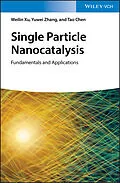Introduces the detailed basis and recent development of single molecule/particle nanocatalysis based on single molecule techniques
This unique book introduces and summarizes the recent development of single molecule/particle nanocatalysis to provide both comprehensive coverage of fundamentals for different methods now in widespread use and the extensive applications in different catalytic systems. Chapters are mainly based on different detection methods, including single molecule fluorescence microscopy, surface plasmon resonance spectroscopy, X-ray microscopy, and surface enhanced Raman spectroscopy. The book also includes numerous basic principles of different methods and application examples and features illustrations that help clarify presentations.
Single Particle Nanocatalysis: Fundamentals and Applications starts with the history and development of single molecule techniques for nanocatalysis. It then shows readers how single molecule fluorescence microscopy (SMFM) reveals catalytic kinetics and dynamics of individual nanocatalysts. Next, it examines traditional SMFM-based single molecule nanocatalysis without super-resolution (SR) imaging, before moving on to the topic of SMFM-based SR imaging in single molecule nanocatalysis. Following chapters cover scanning electrochemical microscopy for single particle nanocatalysis; surface plasmon resonance spectroscopy for single particle nanocatalysis/reactions; X-ray-based microscopy of single-particle nanocatalysis; and surface-enhanced Raman spectroscopy for single particle nanocatalysis. The book finishes by introducing some less-practiced techniques for single particle nanocatalysis/electrochemistry.
-Presents a systematical and complete introduction to the subject of single particle nanocatalysis?covering all of its fundamentals and applications
-Helps readers fully understand the basis, role, and recent development of single molecule nanocatalysis
-Teaches researchers how to gain new knowledge to successfully conduct their own studies within this rapidly increasing new area of research
Single Particle Nanocatalysis: Fundamentals and Applications is an excellent reference book for experts in this area as well as for general researchers who want to learn how to study nanocatalysis at single molecule/particle level.
Autorentext
Weilin Xu, PhD, is Professor at Changchun Institute of Applied Chemistry, Chinese Academy of Sciences. He focuses on energy process related basic and practical research.
Yuwei Zhang, PhD, is Associate Professor at Changchun Institute of Applied Chemistry, Chinese Academy of Sciences. Her research is currently on single particle nanocatalysis.
Tao Chen, PhD, obtained his PhD from Changchun Institute of Applied Chemistry, Chinese Academy of Sciences, where he studied the nanocatalysis at single particle level based on single molecule fluorescence spectroscopy.
Klappentext
Introduces the detailed basis and recent development of single particle nanocatalysis based on single molecule techniques
This unique book introduces and summarizes the recent development of single particle nanocatalysis to provide both comprehensive coverage of fundamentals for different methods now in widespread use and the extensive applications in different catalytic systems. Chapters are mainly based on different detection methods, including single molecule fluorescence microscopy, surface plasmon resonance spectroscopy, X-ray microscopy, and surface enhanced Raman spectroscopy. The book also includes numerous basic principles of different methods and application examples and features illustrations that help clarify presentations.
Single Particle Nanocatalysis: Fundamentals and Applications starts with the history and development of single molecule techniques for nanocatalysis. It then shows readers how single molecule fluorescence microscopy (SMFM) reveals catalytic kinetics and dynamics of individual nanocatalysts. Next, it examines traditional SMFM-based single particle nanocatalysis without super-resolution (SR) imaging, before moving on to the topic of SMFM-based SR imaging in single particle nanocatalysis. Following chapters cover scanning electrochemical microscopy for single particle nanocatalysis; surface plasmon resonance spectroscopy for single particle nanocatalysis/reactions; X-ray-based microscopy of single particle nanocatalysis; and surface-enhanced Raman spectroscopy for single particle nanocatalysis. The book finishes by introducing some less-practiced techniques for single particle nanocatalysis/electrochemistry.
- Presents a systematical and complete introduction to the subject of single particle nanocatalysiscovering all of its fundamentals and applications
- Helps readers fully understand the basis, role, and recent development of single particle nanocatalysis
- Teaches researchers how to gain new knowledge to successfully conduct their own studies within this rapidly increasing new area of research
Single Particle Nanocatalysis: Fundamentals and Applications is an excellent reference book for experts in this area as well as for general researchers who want to learn how to study nanocatalysis at single particle level.
Inhalt
Preface xi
1 The History/Development of Single Particle Nanocatalysis 1
1.1 History of Single Particle Nanocatalysis Based on Single Molecule Fluorescence Microscopy 2
1.2 History of Single Particle Nanocatalysis Based on (Localized) Surface Plasmon Resonance 3
1.3 History of Single Particle Nanocatalysis Based on Scanning Electrochemical Microscopy 4
1.4 History of Single Particle Nanocatalysis Based on Vibrational Spectroscopies 5
References 6
2 Single Molecule Nanocatalysis Reveals Catalytic Kinetics and Thermodynamics of Individual Nanocatalysts 9
2.1 Single Molecule Enzymology 9
2.1.1 Single Molecule MichaelisMenten Kinetics in the Absence of Dynamic Disorder 9
2.1.2 Single Molecule MichaelisMenten Kinetics with Dynamic Disorder 13
2.1.3 Randomness Parameter 20
2.1.4 Single Molecule MichaelisMenten Kinetics for Fluorogenic Reaction in the Absence of Dynamic Disorder 21
2.2 Physical Models for Kinetic and Dynamic Analysis of Single Molecule Nanocatalysts 23
2.2.1 LangmuirHinshelwood Mechanism for Noncompetitive Heterogeneous Catalysis 23
2.2.1.1 LangmuirHinshelwood Mechanism for Product Formation 24
2.2.1.2 Two-Pathway Model for Production Dissociation 27
2.2.1.3 Overall Turnover Rate 29
2.2.2 LangmuirHinshelwood Mechanism for Competitive Heterogeneous Catalysis 30
2.3 Comparison Between MichaelisMenten Mechanism and Noncompetitive Langmuir Hinshelwood Mechanism 31
2.4 MichaelisMenten Mechanism Coupled with Multiple Product Dissociation Pathways 32
2.4.1 Product Dissociation Process 32
2.4.2 Product Formation Process 33
2.5 Application of LangmuirHinshelwood Mechanism to Oligomeric Enzymes 35
2.6 Applications of Competitive/Noncompetitive LangmuirHinshelwood Models in Single Molecule Nanocatalysis 35
2.6.1 Applications of Noncompetitive LangmuirHinshelwood Models in Single Molecule Nanocatalysis 35
2.6.1.1 Single Molecule Nanocatalysis on Single Au Nanoparticles 35
2.6.1.2 Single Molecule Photocatalysis on Single TiO2 Nanoparticles 38
2.6.2 Applications of Competitive LangmuirHinshelwood Models in Single Molecule Nanocatalysis 41
2.6.2.1 Single Pt Nanocatalyst Behaves Differently in Different Reactions 41
2.6.2.2 Single Molecule Nanocatalysis at Subparticle Level 42
2.7 Single Molecule Nanocatalysis Reveals the CatalyticThermodynamics of Single Nanocatalysts 44
